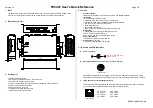
16
AIM-OM-ATX-3, Rev. 2.1, 05/15
• Copyright Orenco Systems
®
, Inc. Property of Orenco Systems
®
, Inc. Do not reproduce or distribute without written authorization from Orenco: 800-348-9843.
AdvanTex
®
O
&
M
MANUAL
C O M M E R C I A L T R E A T M E N T S Y S T E M S
Preventive Maintenance
As with any engineered system, such as a car or heat pump, your
wastewater treatment system will work better and last longer if it is
regularly maintained by a qualified service provider. The service provider
should be present during installation, so he or she is familiar with the
system, especially those service lines, conduits, and connections that get
buried.
Your system will work better and last longer if you learn what not to
put into the treatment system. There should be no disposal of toxics or
chemicals into the system, such as restaurant degreasers, cleansers, wax
strippers for linoleum, carpet shampoo and its waste products, and other
toxics. As a general rule, nothing should go into any wastewater treatment
system that hasn’t been ingested, other than toilet tissue, mild detergents,
and wash water. Every system user and qualified service provider should
be familiar with the basic guidelines below:
• No septic additives
• No flammable or toxic products
• No excessive use of household cleaners or chlorine bleach
• No pool or spa products
• No disposing of pharmaceuticals
• No pesticides, herbicides, or agricultural chemicals or fertilizers
• No RV waste (unless the system is specifically designed and
engineered to treat such waste)
• No surface runoff and storm water
• No excessive amounts of fats, oils and grease (FOG)
• No food byproducts
• No cigarette butts
• No paper towels, newspapers, sanitary napkins, diapers, disposable
wipes, floss, gum or candy wrappers, etc.
• No chlorides or water softener backwash
Preventive maintenance should start with facility user and/or homeowner
education. Orenco Systems
®
, Inc. can provide a manual of Do’s and
Don’ts to distribute upon request. To request multiple copies of this
manual, contact Orenco Systems, Inc. at 1-800-348-9843.
With preventive maintenance and periodic inspections, the wastewater
treatment system will function for decades.
Scheduled Maintenance
Scheduled maintenance should be performed in the time frames described
in this section. A chart showing scheduled maintenance activities and times
is included at the end of this section, for your convenience.
Monthly Maintenance
Once a month, during the first year of operation, make a visual inspection
of the liquid levels in the septic, recirculation/blend, and dosing tanks. The
liquid level should never be lower than the “Redundant Off” float. If liquid
leaks out of the tank, the scum layer can drop to the level of the perimeter
holes in the pump vaults and cause the screen to plug. A watertight tank is
important and any leakage must be corrected.
During the first year of operation, check the Biotube
®
filter in the septic tank
every month and clean when necessary. Follow the applicable instructions
found in Appendix B for cleaning Biotube filters.
Once a month, during the first year of operation, the Biotube Pump
Vaults should be examined to determine if cleaning of the Biotube filter is
necessary. If the liquid level inside the vault is discernibly different from the
level outside the pump vault while the pump is running, cleaning is required.
Remove the filter cartridge and clean it following the applicable instructions
in Appendix B.
Once a month, read the hour meters and event counters for the
recirculating/blend and dosing tank’s pumps. Each pump should run
approximately the same number of hours and turn on approximately the
same number of times as their operating counterpart. If the run times or
cycle times differ significantly between pumps, determine the cause of the
discrepancy and take corrective measures.
If there is a distributing valve, manually cycle the valve through every outlet
to confirm proper operation.
Maintenance (continued)
Scum Layer
Slope Ground Away from Riser
Effluent
Discharge
Biotube Pump
Vault
Inlet Tee
Clear Zone
Sludge Layer









































